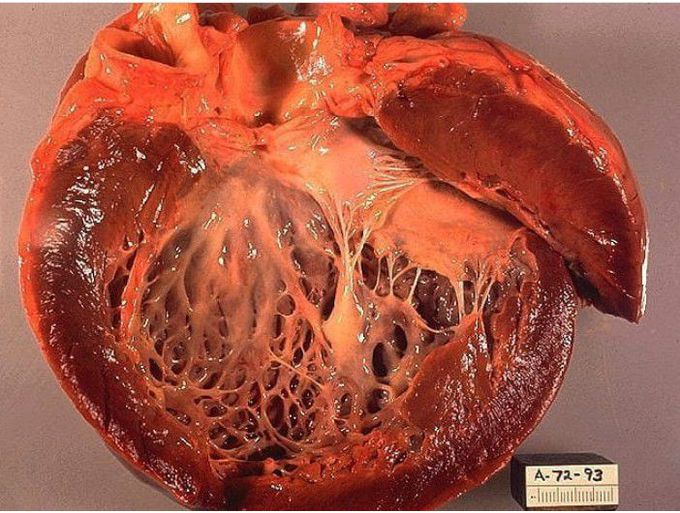


Dilated cardiomyopathy
Dilated cardiomyopathy is a condition in which the heart muscle becomes weakened, stretched and enlarged. As a result, the heart cannot pump sufficient blood to the rest of the body. CAUSES: The most common causes of dilated cardiomyopathy are: Narrowing or blockage in the coronary arteries Poorly controlled high blood pressure Alcohol or cocaine abuse Diabetes, thyroid disease, or hepatitis Drugs that can be toxic to the heart, such as ones used to treat cancer Cardiac arrhythmia Autoimmune diseases Genetic causes Infections that involve the heart muscle Heart valves that are either too narrow or too leaky During the last month of pregnancy, or within 5 months after the baby is born. Exposure to heavy metals such as lead, arsenic, cobalt, or mercury. SYMPTOMS: Heart failure is the most common symptom other common symptoms are: Chest pain or pressure (more likely with exercise) Cough Fatigue, weakness, faintness Irregular or rapid pulse Loss of appetite Shortness of breath Swelling of feet and ankles DIAGNOSIS: Several diagnostic tests are done including: electrocardiogram, echocardiogram, chest X-ray, CT scan, blood test, exercise stress test,cadiac catheterization etc.During the exam, the patient is diagnosed with: Enlarged heart. Lung crackles (a sign of fluid buildup), heart murmur, or other abnormal sounds. Possible liver enlargement Bulging veins of the neck. TREATMENT: Treatment for the underlying cause is recommended. Other than that several medicines are recommended such as: Angiotensin-converting enzyme (ACE) inhibitors. ... Angiotensin II receptor blockers (ARBs) Sacubitril/valsartan (Entresto) Beta blockers Diuretics Digoxin (Lanoxin) Ivabradine (Corlanor) Blood-thinning medications (anticoagulants) Heart transplant surgery and certain Implantable devices are also employed. Credits: https://www.instagram.com/p/CMZ-N1gnuXC/?igshid=1is2i7fk881cm https://medlineplus.gov/ency/article/000168.htm#:~:text=Dilated%20cardiomyopathy%20is%20a%20condition,result%20of%20different%20underlying%20conditions.
Thank you for the information But it seems more hypertrophic than dilated


